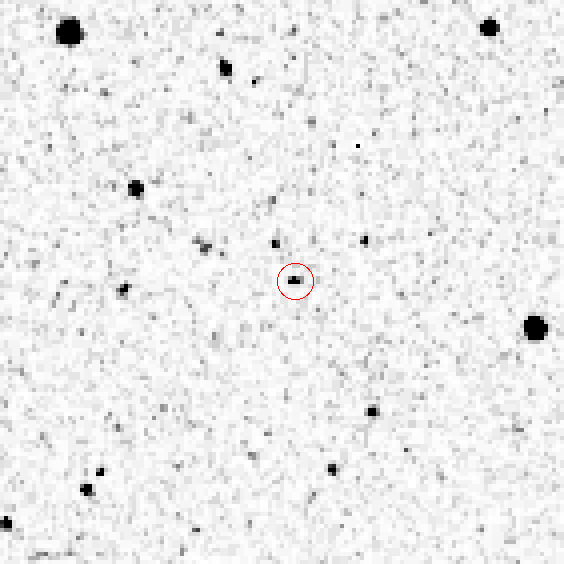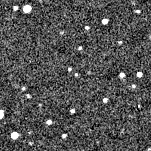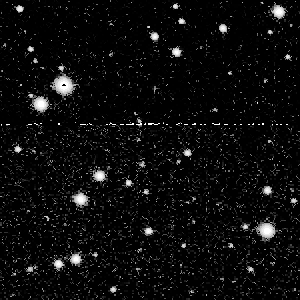
Below is the earliest known image of the asteroid 65363 Ruthanna. The image was shot as part of the Palomar sky survey on August 11, 1951, and is reproduced here courtesy of the USNOFS Image and Catalogue Archive operated by the United States Naval Observatory.

The asteroid "Ruthanna" was discovered by Joe Dellinger on the evening of Tuesday, August 6, 2002. I was out at the George observatory that night helping with a presentation for a major Houston museum of natural science benefactor, Mr. Gueymard, who had endowed the observatory with a trust fund for the upkeep of our big telescope some time before. We thought it only appropriate to name our 1999 RN33 in his honor, and that evening showed him computer images of "his" asteroid, and gave him a tour of the telescopes. Unfortunately, we were not able to show any of the assembled dignitaries anything through the telescopes, because the night was hopelessly cloudy!
After the Gueymard reception was over I hung around to see if it would clear up. Paul Garossino had been out the night before, on a similarly hopeless night, and had managed to shoot followup on a recent asteroid discovery of ours, 2002 PE, during a brief clearing. I had brought along my laptop and did the astrometry on Paul's data while I waited. There appeared to be an interesting object in Paul's data that was worth following up, so I waited a bit longer.
Followup is vitally important when discovering asteroids. One night's observations is enough to know that you have seen something new, but not (usually) enough to get any credit. It's too easy for that one night's observations to be in error. A second night's observations is required to get official recognition as having discovered a new object. Yet a third night is necessary before you can even begin to determine a real orbit for the object, so that you have a hope of being able to find it more than a few days later. (At that point, a week's cloudy weather can ruin all your hard work, with the object lost into the vastness of the sky again.)
Observations over a span of about one to two months are required if you want to be able to find the object again a year later. About four years' worth of observations are required before the object is considered to be sufficiently well characterized that it is never going to get lost, and becomes eligible for permanent numbering.
By about 10:30PM it cleared enough to convince me to risk setting all the equipment up, a process that takes about 30-40 minutes (with a similar time required for tear-down at the end). I also very much wanted to image the asteroid 2002 NY40, which would be making a very close pass by Earth just a week and a half later.
My patience was rewarded and I got a good hour of clear-enough skies. About 12:30 a big lightning storm started blowing up in the East and the sky rapidly went from clear to cloudy to threatening, so I tore down and went home.
However, as Paul wrote about the previous night:
It always seems that going out on hopeless nights is rewarded greatly. That F28063 is about Mag 17.3 and is a very nice looking target. Joe shot this field again the other night, again a hopeless night, the night of the Gueymard presentation. If we end up getting this one we should let Mr. Gueymard know, that would be cool.The name "F28063" simply indicates the 3rd object our astronomy club observed on August 6, 2002. August 6 universal time was the evening of Monday, August 5, Houston time. As it turned out, when I processed my data the next evening I had indeed managed to get another night on Paul's discovery.

F28063 (F28074 F28074 K02P11QThis is code for "we recognize that F28063 is the same object at F28074, which we recognize as a new discovery, 2002 PQ11". As occasionally happens, the discovery was awarded to the second night, instead of the first. In this case, there was a simple explanation: Paul had not shot the field for very long before being clouded out, and so his data did not characterize the asteroid's velocity as well as my data from the next night had.
Officially, I was the sole discoverer, having "stolen" the object from Paul. The cryptic name assigned by the Minor Planet Center, 2002 PQ11, indicates that this was the 291st asteroid discovery of the first half of August, 2002. (The first asteroid of the year 2002 would be 2002 AA, up to 2002 AZ, then 2002 AA1, to 2002 AZ1, etc. The first asteroid of the second half of January would be 2002 BA, etc. The letter "I" is not used, to avoid mistaking it for "1", but the letter "O" is used even though it looks a lot like "0" to me!)
After one more observation, the Minor Planet Center realized that our new discovery already existed in their database. We had rediscovered "1999 XK246":
*** Match found for K02P11Q
Line was: K02P11Q
J99XO6K MPC
K02P11Q 16.5 0.15 K0256 347.548 290.187 2.710 2.098 0.21861 2.37237 3 X
Bill Dillon translated this report into English:
Very good news indeed! Our very bright PQ11 linked to 1999 XK246, and we keep the primary designation! Furthermore, that data linked to a Spacewatch sighting in 1996, so PQ11 is now a 3-opposition object. It's sure to get numbered next opposition. The orbit is a bit eccentric, which probably slowed its discovery process. I think our extending the arc to 5 days helped make the link, and helped us in snagging the primary designation.In fact, 2002 PQ11 became numbered even faster than that. With a 6-year arc, Andrew Lowe of Calgary, Alberta, Canada was then able to find the above "precovery" image taken way back in 1951 by the Palomar all-sky survey, extending the orbital arc to 51 years. Andrew is one of the world's best at mining overlooked asteroid observations out of archival sky-survey plates. Andrew wrote:
The "trail" of 2002 PQ11 on 1951 Aug 11 is enclosed. You might look at it and ask where the asteroid is. Well, it's precisely at the center of the plot, but because it was nearly at a stationary point, the trail is only 6.2" long. Combine that with the plate scale of the first Palomar Survey and you have a fairly wimpy-looking trail. But that was the only trail I ever did find for 2002 PQ11.
To make the asteroid clear, I circled it in the above image. If you look closely, though, you can see that it is slightly elongated left-right by the asteroid's motion.
Andrew's single historical observation was enough to nail down the orbit so that 2002 PQ11 was officially assigned a number, asteroid 65363. This was one of those rare discoveries where everything just magically worked, and we went from discovery to a numbered, namable object very quickly.
In 2003 I proposed naming the asteroid "Ruthanna", in honor of my Aunt, who had recently lost a long battle with cancer.
(65363) Ruthanna = 2002 PQ11
Discovered 2002 Aug. 7 by Joe Dellinger at the George Observatory,
Brazos Bend State Park, Needville, Texas.
Named in memory of Ruthanna Dellinger Powell (1933-2003), beloved aunt of
the discoverer. The youngest child of a large Indiana farm family, devoted
lifelong wife of Tommy Powell, and mother of three, she brought peace,
love, and joy to all around her, and faced life with quiet courage through
tragedy and illness.
The name was accepted and at the start of 2004 became official.
Aunt Ruthanna, I wish we could have you back, but here is an asteroid
to remember you by!
Here is an animation of Ruthanna's orbit, courtesy of JPL. The object can be relatively bright if Earth happens to pass it on the inside track in August, as was happening at discovery in August 2002.

We later found out that the NEAT survey had observed Ruthanna six times over the course of an hour on May 23, 2002. If they had turned in their data promptly, they could have scooped us on discovery by two and a half months! Andrew Lowe found the above images on the SkyMorph web site. (SkyMorph is supported by NASA's AISR program.)